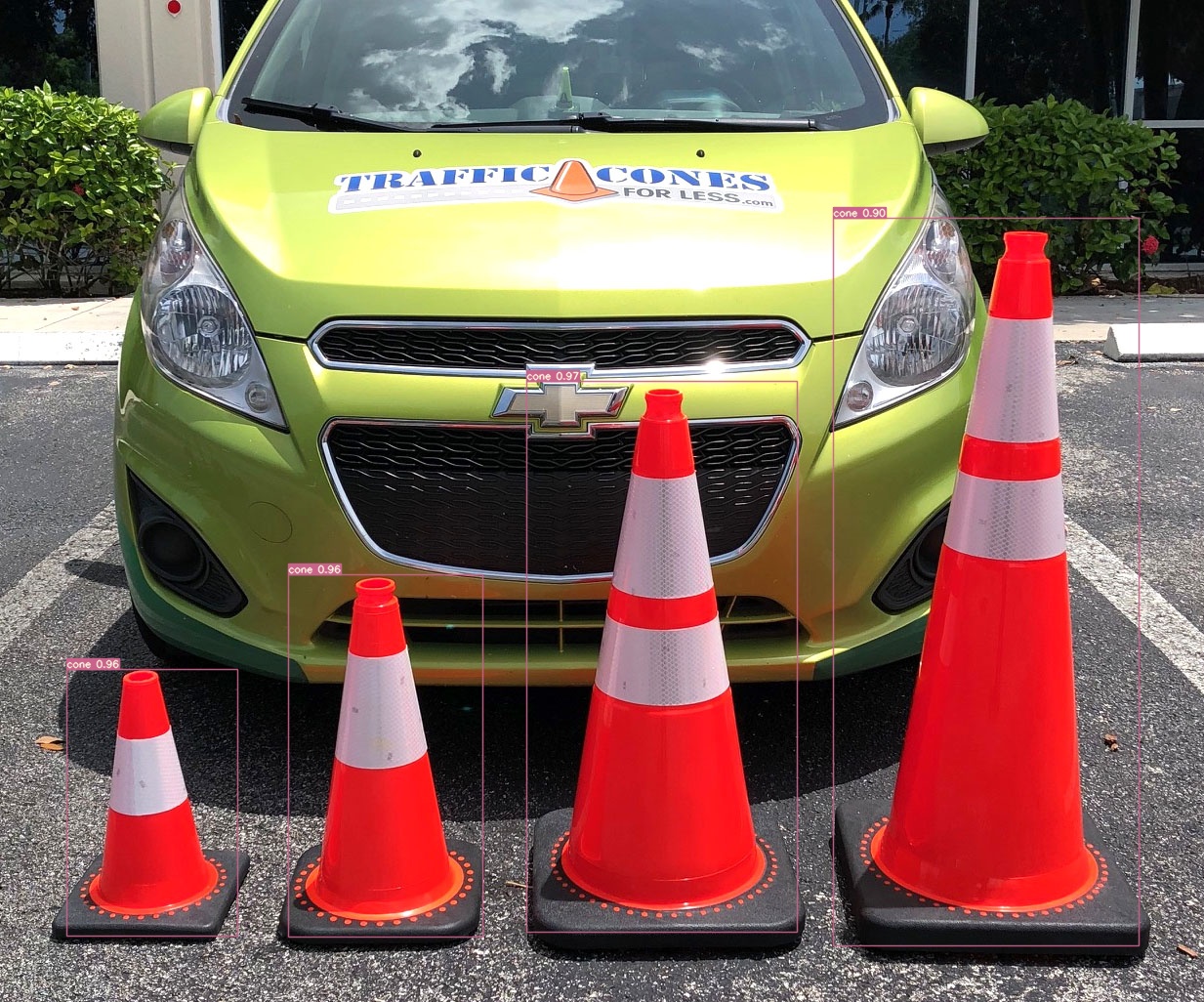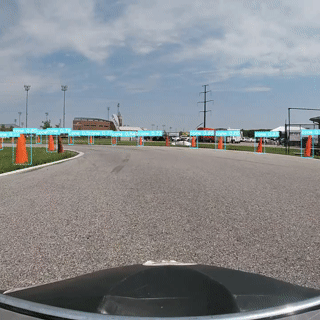Coneslayer is a product of the Kennesaw State University's Electric Vehicle Team (ksuevt.org). This repository is licensed under the GPL-v3.0 license, see LICENSE for details
Coneslayer is a lightweight neural-network object detection model for rapid detection of orange traffic cones in static or dynamic scenes. Its design is based on yolov7-tiny, a state of the art rapid object detection framework. Coneslayer is designed to run at at least 30fps live on edge devices, such as the Intel Movidius Myriad X VPU integrated in the Luxonis OAK-D Pro camera.
The core of coneslayer was trained on a set of over 10,000 hand-labeled images of homogeneous cones. About 2600 of these were generated automatically from GoPro footage then labeled by hand by members of the KSU EVT team:
| Person | Images Labeled |
|---|---|
| Brandon Solon | 1171 |
| Toai Dong | 502 |
| Hanson Chaney | 491 |
| Matthew Krupczak | 420 |
| Seth Canada | 100 |
| Ethan Leitner | 56 |
| Sahan Reddy | 25 |
| Fernando Martinez | 11 |
Our own dataset was mixed at a 1 : 3 ratio with a customized subset of the FSOCO dataset containing just large and small orange traffic cones.
This resulted in a model that performed well on cones similar to those of the training set, but generalized poorly to complex scenes in the real world.
To remedy this issue, a series of transfer learning sessions were performed on a heterogeneous labeled dataset of about 800 items, with 500 images sourced from Google Search (from all over the world), screenshots of dashcam video from driving around Midtown Atlanta, and smartphone pictures of cones. An additional 300 images of complex scenes (from dashcam video) labeled as lacking traffic cones were used as negative training data.
A full writeup describing this process is available in the link below:
https://matthew.krupczak.org/2022/12/13/coneslayer-a-neural-network/
Clone WongKinYiu's yolov7 repository and follow its installation instructions (an alternate install method is to use a python virtualenv instead of a container).
Copy coneslayer.pt into your yolov7 directory. Source the python virtualenv as normal:
source yolov7/bin/activateInstall prerequisites for yolov7 for the virtualenv:
python -m pip install requirements.txtFinally, run the command:
python3 detect.py --weights coneslayer.pt --conf 0.54 --iou 0.50 --img-size 416 --source ~/Path/To/ImagesAlternatively, this repo uses the Luxonis Depthai Python SDK to obtain depth values for cones detected using the OAK-D: https://gitlab.com/KSU_EVT/autonomous-software/yolov7-luxonis-detection
You may also use one of the converted versions of the model, such as coneslayer_openvino_2021.4_6shave.blob, coneslayer-simplified.onnx, or coneslayer.bin created using tools.luxonis.com. Usage as such may require an associated metadata file in either XML or JSON format.
A moderately larger Coneslayer model, "Coneslayer Redux" is now available in the coneslayer-redux folder. It has an increased input size of 640x640 and is based on the YOLOv7 base model with ~32 million parameters, versus the original Coneslayer's 6 million. It was trained using the same methodology as Coneslayer, but the larger model size may allow it to be more accurate despite a reduced speed of inference.
To run coneslayer-redux, clone this repo and copy coneslayer-redux.pt to your yolov7 directory. Perform the same steps as listed previously to establish your virtualenv (if you haven't done so already)
Finally, run the command:
python 3 detect.py --weights coneslayer-redux.pt --conf 0.54 --iou 0.50 --img-size 640 --source ~/Path/To/ImagesYou may also use one of the converted versions of the model, such as coneslayer-redux_openvino_2022.1_6shave.blob, coneslayer-redux-simplified.onnx, or coneslayer-redux.bin created using tools.luxonis.com. Usage as such may require an associated metadata file in either XML or JSON format.
An even larger Coneslayer, with an increased input size of 1280x1280 and based on YOLOv7-E6E with ~152 million parameters versus YOLOv7-tiny's 6 million, was trained using 4x V100 32Gb for about 120 computer hours. It is available from this repository only as the pytorch binary and not the onyx or other formats.
To run coneslayer-deluxe, clone this repo and copy coneslayer-deluxe.pt to your yolov7 directory. Perform the same steps as listed previously to establish your virtualenv (if you haven't done so already)
Finally, run the command:
python3 detect.py --weights coneslayer-deluxe.pt --conf 0.54 --iou 0.50 --img-size 1280 --source ~/Path/To/ImagesThe architecture for coneslayer is based on yolov7-tiny, which has just over 6 million parameters. It is very small for a model of its kind, and its design sacrifices accuracy and specificity in favor of speed. Attempts have been made to make the model as specific as possible, however false positives will occur in complex scenes such as those encountered while driving. Do not use coneslayer in any safety-critical environment.
Coneslayer is not designed to detect non-conical traffic objects, such as traffic channelizers or barrels, or cones of a hue differing from orange.
Ethan Leitner performed much of the prototyping and demonstrated a proof of concept based on yolov4-tiny. His experience was vital in switching to a yolov7-tiny based model.
Yonnas Alemu and Sahan Reddy developed a tool to obtain a subset of the FSOCO dataset. Brandon Solon labeled over 1000 images, with up to a dozen cones per image, by hand. These and other contributors' data were instrumental in building the core of coneslayer.
Dr. Lance Crimm advised our efforts and provided access to the Kennesaw State University's High Performance Computer which was used for numerous training sessions and iterations.
GitHub user MarkDana and their yolov4-based RealtimeConeDetection repo served as inspiration for this project.



